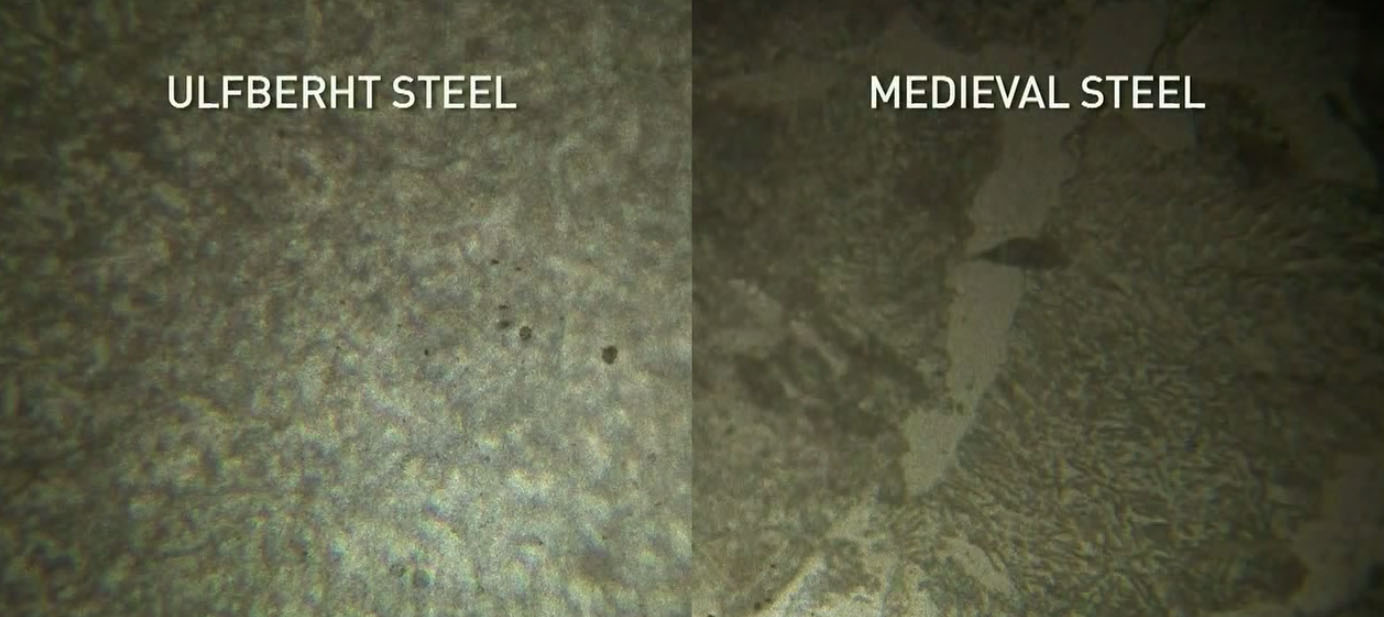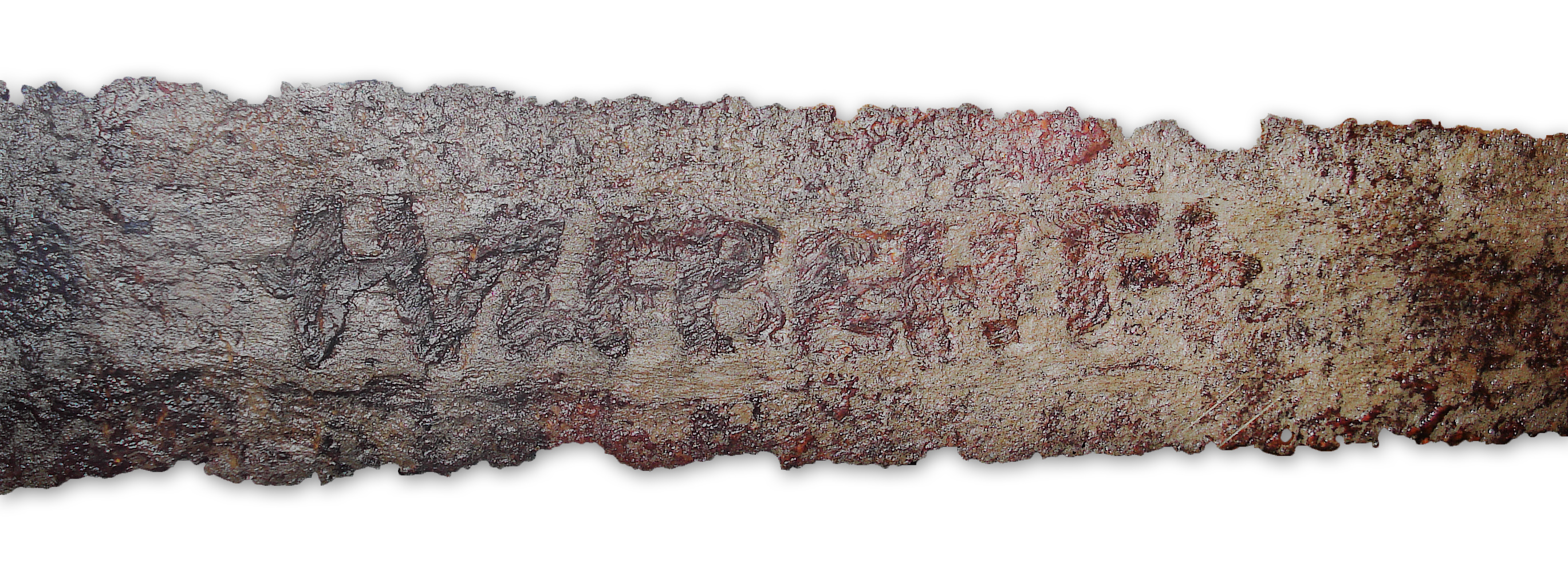It looks like you're using an Ad Blocker.
Please white-list or disable AboveTopSecret.com in your ad-blocking tool.
Thank you.
Some features of ATS will be disabled while you continue to use an ad-blocker.
24
share:
The steel in a common Norse Viking swords were nothing special compared to other parts of Europe at the time. But recent analysis of Norse Viking
swords marked with the text "Ulfberht" are remarkable; the steel in these swords is so pure that it would take the rest of Europe another 800 years to
match the same steel quality.
 Ulfberht steel had fewer inpurities compared to contemporary steel and a much higher carbon content.
Ulfberht steel had fewer inpurities compared to contemporary steel and a much higher carbon content.
Where did this technology come from? The Ulfberht is an impossible artifact for the time, but yet again we have the proof that people in the Early Middle Ages where a lot more technological advanced than our history books tell us.
 Close-up photo of a real Ulfberht sword.
Close-up photo of a real Ulfberht sword.
The Ulfberht was most likely a sword for the Norse Viking elite and not the common man, and only 171 Ulfberht swords have been found in Norse burial grounds and in lakes to this day. The Ulfberht steel production method was probably kept secret by a few blacksmiths to prevent this amazing technology falling into the hands of their enemies.
-MM

Where did this technology come from? The Ulfberht is an impossible artifact for the time, but yet again we have the proof that people in the Early Middle Ages where a lot more technological advanced than our history books tell us.

The Ulfberht was most likely a sword for the Norse Viking elite and not the common man, and only 171 Ulfberht swords have been found in Norse burial grounds and in lakes to this day. The Ulfberht steel production method was probably kept secret by a few blacksmiths to prevent this amazing technology falling into the hands of their enemies.
-MM
edit on 30-11-2014 by MerkabaMeditation because: (no reason given)
edit on 30-11-2014 by MerkabaMeditation because: (no reason
given)
I remember seeing a NOVA documentary about these swords, very advanced for there time and were only made for a relitivly short period of time. Then it
seems the knowledge of how to create the refined steel was lost and not rediscovered for hundreds of years. I think there were even rumors of the
metal used to make them having come from a meteor.
Cool first time I hear of them so I Google it and it seems it was the nike of the time
They made Chinese knockoff back them too
1,000 years on, perils of fake Viking swords are revealed
Some Viking swords were among the best ever made, still fearsome weapons after a millennium. The legendary swords found at Viking sites across northern Europe bear the maker's name, Ulfberht, in raised letters at the hilt end. Puzzlingly, so do the worst ones, found in fragments on battle sites or in graves.
The Vikings would have found it impossible to tell the difference when they bought a newly forged sword: both would have looked identical, and had razor sharp blades. The difference would have only emerged in use, often fatally.
Williams began to test the Ulfberht blades when a private collector brought one into the Wallace, and found they varied wildly. The tests at the NPL have proved that the inferior swords were forged in northern Europe from locally worked iron. But the genuine ones were made from ingots of crucible steel, which the Vikings brought back from furnaces thousands of miles away in modern Afghanistan and Iran. The tests at Teddington proved the genuine Ulfberht swords had a phenomenally high carbon content, three times that of the fakes, and half again that of modern carbon steel.
They made Chinese knockoff back them too
1,000 years on, perils of fake Viking swords are revealed
Im 99% positive they figured out they came from France, the empire. The one documentary showed that there were knockoffs made locally, some with the
name spelled wrong, and inferior material. There are even references to Frankish weapons in the eddas.
a reply to: MerkabaMeditation
Cool thread, i thought that they had maybe encountered Wootz Steel via trade links. I did a thread today on a Norse smithing kit today in ancient civs, there is a pdf linked there with metallurgical analysis at the end which you may find interesting.
Cool thread, i thought that they had maybe encountered Wootz Steel via trade links. I did a thread today on a Norse smithing kit today in ancient civs, there is a pdf linked there with metallurgical analysis at the end which you may find interesting.
The Open University used to have lectures on steel production. All the factors that influenced the manufacture of steel included percentages of
impurities (sulphur, heavy metals), percentage of carbon, cooling time for crystals to grow and interlock. Fast cooling produced small crystal grains,
slow cooling produced larger crystals grains. To produce engine blocks they would let the metal cool down over days, so that it essentially was one
crystal.
The makers would have known about the cooling process, and also that different regions would have steel of different strengths due to the natural impurities. Perhaps they could have worked out a world map of where to obtain the best steel.
The makers would have known about the cooling process, and also that different regions would have steel of different strengths due to the natural impurities. Perhaps they could have worked out a world map of where to obtain the best steel.
a reply to: punkinworks10
It's figging outstanding in the photo, so wow!
I'd love to see what an Ulfbehrt looked like prior to a thousand years underground.... i've seen plenty of pattern welds and damascus etc, but i'd really like to know for certain.
It's figging outstanding in the photo, so wow!
I'd love to see what an Ulfbehrt looked like prior to a thousand years underground.... i've seen plenty of pattern welds and damascus etc, but i'd really like to know for certain.
The Norse had close connections with the Byzantine empire, often taking positions as mercenaries, as such they would have had access to all the trade
goods of the east to include high quality iron.
The Varangian Guard was made up of northern Europeans and many Norse. The Norse got there by way of the Russian river network. The unit existed from the 10-14th century.
The Varangian Guard was made up of northern Europeans and many Norse. The Norse got there by way of the Russian river network. The unit existed from the 10-14th century.
a reply to: Hanslune
That is one of the theories in the documentary, that the Vikings traded furs for steel - the Norse steel is similar to Damaskus Steel but not identical and have slightly different properties.
-MM
That is one of the theories in the documentary, that the Vikings traded furs for steel - the Norse steel is similar to Damaskus Steel but not identical and have slightly different properties.
-MM
edit on 30-11-2014 by MerkabaMeditation because: (no reason given)
Well i'm only half way through the doc but wanted to reply now in case something got in the way of me doing it later - it's a great documentary so far
and not many are up to this standard any more, many thanks for posting it
Good to see it was likely crucible steel from Iran, i wasn't too far off at least
ETA: There really is very little that a man with a proper beard cannot achieve.
Good to see it was likely crucible steel from Iran, i wasn't too far off at least
ETA: There really is very little that a man with a proper beard cannot achieve.
edit on 30-11-2014 by skalla because: (no reason
given)
new topics
-
God's Righteousness is Greater than Our Wrath
Religion, Faith, And Theology: 3 hours ago -
Electrical tricks for saving money
Education and Media: 6 hours ago -
VP's Secret Service agent brawls with other agents at Andrews
Mainstream News: 8 hours ago -
Sunak spinning the sickness figures
Other Current Events: 8 hours ago -
Nearly 70% Of Americans Want Talks To End War In Ukraine
Political Issues: 9 hours ago -
Late Night with the Devil - a really good unusual modern horror film.
Movies: 10 hours ago
top topics
-
VP's Secret Service agent brawls with other agents at Andrews
Mainstream News: 8 hours ago, 9 flags -
Cats Used as Live Bait to Train Ferocious Pitbulls in Illegal NYC Dogfighting
Social Issues and Civil Unrest: 12 hours ago, 8 flags -
Electrical tricks for saving money
Education and Media: 6 hours ago, 4 flags -
HORRIBLE !! Russian Soldier Drinking Own Urine To Survive In Battle
World War Three: 16 hours ago, 3 flags -
Nearly 70% Of Americans Want Talks To End War In Ukraine
Political Issues: 9 hours ago, 3 flags -
Sunak spinning the sickness figures
Other Current Events: 8 hours ago, 3 flags -
Late Night with the Devil - a really good unusual modern horror film.
Movies: 10 hours ago, 2 flags -
The Good News According to Jesus - Episode 1
Religion, Faith, And Theology: 14 hours ago, 1 flags -
God's Righteousness is Greater than Our Wrath
Religion, Faith, And Theology: 3 hours ago, 0 flags
active topics
-
How ageing is" immune deficiency"
Medical Issues & Conspiracies • 34 • : angelchemuel -
Nearly 70% Of Americans Want Talks To End War In Ukraine
Political Issues • 13 • : Freeborn -
Mood Music Part VI
Music • 3101 • : ThatSmellsStrange -
VP's Secret Service agent brawls with other agents at Andrews
Mainstream News • 41 • : ThatSmellsStrange -
HORRIBLE !! Russian Soldier Drinking Own Urine To Survive In Battle
World War Three • 32 • : DaRAGE -
New whistleblower Jason Sands speaks on Twitter Spaces last night.
Aliens and UFOs • 55 • : baablacksheep1 -
Cats Used as Live Bait to Train Ferocious Pitbulls in Illegal NYC Dogfighting
Social Issues and Civil Unrest • 20 • : Asher47 -
Electrical tricks for saving money
Education and Media • 4 • : Lumenari -
DONALD J. TRUMP - 2024 Candidate for President - His Communications to Americans and the World.
2024 Elections • 514 • : WeMustCare -
The Acronym Game .. Pt.3
General Chit Chat • 7744 • : bally001
24

